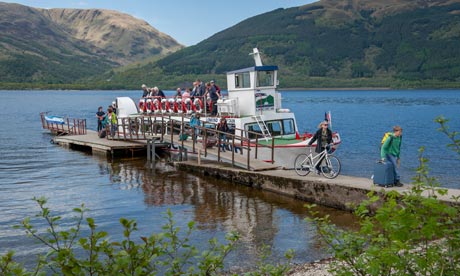
Boarding the boat at Loch Lomond as the mid-morning mist clears over the Munros, we leave the coaches of daytrippers behind. Only a handful of passengers are making the 30-minute journey from Tarbet to Inversnaid. Two couples board first, all in their 60s, all with muscular thighs and well-used walking poles. Then there's us – three friends with hire bikes and not a shred of Lycra between us.
We've come for a quick-fix hit of the great outdoors: to cycle a stretch of the Old Military Road, built on the orders of Field Marshal George Wade in the 18th century for better access to his garrisons. For years it was little more than a faint outline in these rugged hills, but in 2002, a local group – Strathard Community Trust – started turning it into a suitable surface for cyclists, walkers and horse riders.
The Forestry Commission pitched in too, and the trail is now almost complete (bar a few final safety checks) and will be opened officially next spring, running for 15 miles from Inversnaid to Aberfoyle. Beyond that, there is a grander plan for a 90-mile east-west path from the start of the Cowal Way in Portavadie to Callander. As yet nameless, it should be finished in 2015 and will make a new alternative to the well-worn West Highland Way, which runs north-south.
If the views on our short stretch are anything to go by, it will be a stunning route. Leaving Inversaid and its lochside waterfall (where the local ferryman's daughter was the inspiration for William Wordsworth's poem To a Highland Girl), the trail leaves the main road and snakes up a hillside covered with long grass, thistles and rosebay willowherb. From up high we had a perfect view over Loch Arklet, which – unlike the gigantic Loch Lomond (the UK's largest body of inland water) – can be taken in with one panoramic swivel of the head.
You have to put some effort in to get up there, though. It's up and down all the way, sometimes steep and often bone-shakingly bumpy. We're just getting into the swing of it when we arrive at Stronachlachar and its Pier Cafe, formerly a waiting room for Victorian passengers catching boats across Loch Katrine. With sunbeams bursting through the grey to light up the mottled hillsides, we've lucked out on the weather, but the cafe's glass-encased veranda and woodburner must be a godsend on colder days.
After a leisurely lunch of vegetable soup and buttery scones, we don't have time to cycle on to Aberfoyle. But we do take a peek at the Royal Cottage just outside Stronachlachar. Perched alone on the edge of Loch Katrine, it was built for Queen Victoria, but she never got to use it because a welcoming 21-gun salute shattered its every window.
Then it's back to the Old Military Road and the ferry – an easy 10-mile round trip. To our surprise, we don't pass another bicycle, although outside the cafe we did see signs of more serious cyclists: the ones with Ordnance Survey maps in weather-proof pouches on their handlebars.
The park is trying to increase its appeal to cyclists – and that includes those "cycling lite", as we are. We've organised our £25pp bike-and-ferry deal with Cruise Loch Lomond (call ahead, as this venture is brand new and they don't yet have many bikes). There's also a new rack of tandems available from local adventure specialist Can You Experience (£25 for three hours, £35 a day).
The hardy or hard-up can wild camp or stay in a hostel: the Inversnaid Bunkhouse, in a converted church, looks nice, with beds in a quad room from £17 a night. But there's also a move towards slightly more upmarket walkers' and bikers' accommodation, such as the newly opened Mhor84 Motel (doubles £80 room-only) in Lochearnhead. Rooms are simple (whitewashed walls and retro bathrooms), but the bar/restaurant is all stylish reclaimed furniture and quirky antler decorations. It's very inviting, and the food counter looks delicious, featuring giant meringues and doorstep sandwiches.
What strikes me most about this national park is how accessible it is. Our base, the new Braeside B&B is a 40-minute drive from Glasgow, in Drymen, a tiny town draped in bunting and home to an inviting array of stone pubs. In our hire car, we seem to be able to crisscross the park in no time, stopping at highlights such as the Drovers Inn in Inverarnan for a whisky ("Scottish pub of the year: 1705", read staff T-shirts), and low lights: the tallest tree in Britain, at Ardkinglas (sorry Scotland, not worth the detour).
In the saddle though, is surely the best way to explore Loch Lomond. Next time, we've vowed to take a longer route. Perhaps attempting the whole east-west path. Perhaps with one of those laminated OS maps. But certainly with a GPS – just in case.
• The trip was arranged with the help of Visit Scotland, with accommodation provided by Braeside B&B (01360 660989, braeside-drymen.co.uk, doubles £70 B&B). Car hire was provided by Arnold Clark Rental (0141 237 4374, arnoldclarkrental.com), from £32 a day). Further information: visitscotland.com/natural
• This article was amended at 10.10am on Monday 26 August to correct a misspelling of Tarbet.

